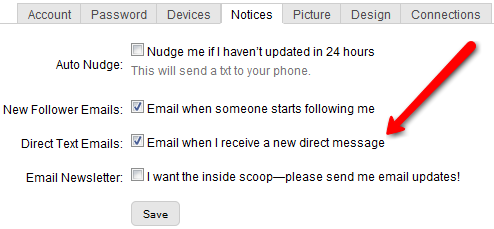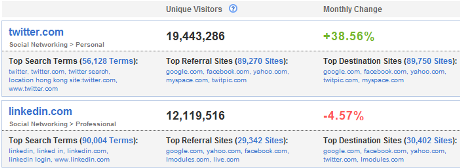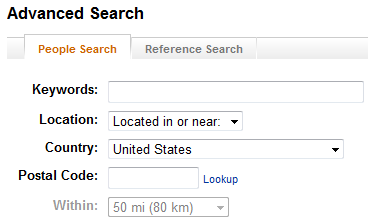 An article posted on the Nielsen Wire blog on April 28, 2009 claimed that more than 60 percent of U.S. Twitter users fail to return the following month. From the number of times I saw people ReTweet and comment about the Nielsen article about Twitter quitters, it seems that many people are intrigued by and concerned about the large number of people who visit and don’t come back to Twitter the next month.
An article posted on the Nielsen Wire blog on April 28, 2009 claimed that more than 60 percent of U.S. Twitter users fail to return the following month. From the number of times I saw people ReTweet and comment about the Nielsen article about Twitter quitters, it seems that many people are intrigued by and concerned about the large number of people who visit and don’t come back to Twitter the next month.
At first, I was a little surprised at the high rate of quitters – a 40% retention rate seems pretty low for something that seems so popular. But then as I started thinking about it, I really don’t care if 60% of the people who visit Twitter in one month don’t come back the next.
Why don’t I care?
Twitter Quitters Leave Data Behind
As a recruiter, I’m pleased whenever I have access to a new resource that I can use to search for and identify talent – the critical first step in the recruiting life cycle. Twitter is highly searchable – if I can find them, I can establish relationships with them, network with them, and recruit them.
But what about all of those Twitter Quitters?
Here’s the thing – if someone visits Twitter and they create a Twitter profile – they leave behind valuable Human Capital Data. Data that can be searched for, analyzed, and acted upon. Even if they only visit once and never come back.
You Can Still Reach Twitter Quitters
Sure, it would be nice if every person who visited Twitter would stay around, Tweet it up, and contribute to the Twittersphere. But they don’t have to for me to be able to find them and even contact them.
As long as someone who’s following me on Twitter checks the box next to the “Email when I receive a new direct message” under the “Notices” tab of their profile settings, I can DM them and they’ll receive an email from me. Even if they never come back to Twitter.
Therefore it is critical to be able to quickly find the right people (people you’d like to network wth and/or recruit at some point), follow them, and ideally elicit a follow-back. As long as you can accomplish this with potential candidates before they “quit” Twitter (temporarily, or permanently), you can still reach them via DM/email.
How can you ensure that potential candidates will follow you back? Ah – great question. It can be done at a surprisingly high success rate, but that’s a topic for another post entirely.
Twitter is Still Growing
While the Nielsen article about Twitter quitters certainly created a concerned buzz, let’s not forget Twitter is still growing strong, increasing the number of unique U.S. visitors by 38.56%, from 14M in March to 19.4M in April. And if you think Twitter’s growing primarily from all of the celebrity exposure in April from the likes of Ashton and Oprah, think again. Twitter actually grew from 7.9M unique U.S. visitors in February to 14M unique U.S. visitors in March – an increase of 6.1M visitors, as compared to the 5.4M added in March to April.
That’s right – Twitter actually added more unique visitors prior to Ashton Kutcher’s challenge to CNN and Oprah showing up on the scene. That surprised me – I had been expecting an acceleration in Twitter’s growth due to all of the exposure Twitter received in April alone. Instead, Twitter’s growth slowed down.
LinkedIn’s Losing Loyalty
While everyone was atwitter about Twitter quitters, in the same time frame that Twitter grew by 38.56%, LinkedIn’s unique U.S. visitors DROPPED 4.57% from approximately 12.7M in March to 12.1M in April.
Yes, it’s a small percentage drop, a relatively small number of people (if you can call nearly 600,000 people a small number), AND LinkedIn’s been around longer than Twitter, but I’m still personally more intrigued by LinkedIn’s drop than in Twitter quitters.
LinkedIn Leavers
I just ran a search on LinkedIn (around 5:00 PM EST, May 17th, 2009) and found that there are 19,918,833 U.S. users with a LinkedIn profile.
Wait a minute – didn’t we just see that LinkedIn only had about 12.1M unique U.S. visitors in April?
Yes – that means that about 7.8M people with a LinkedIn profile did not return to/visit LinkedIn in April. While I haven’t been able to concoct a catchy rhyme to match the likes of “Twitter Quitters,” I can take an alliterative approach and label the 39% of people with a LinkedIn profile who did not visit LinkedIn in April “LinkedIn Leavers.”
Conclusion
The Nielsen post only claimed that more than 60 percent of U.S. Twitter users fail to return the following month. That doesn’t mean they won’t or don’t EVER come back. As we have seen with LinkedIn, not every user of a given social media application actually returns every month.
The people who come to Twitter and “get it” DO stick around – they are the ones who make Twitter awesome. It’d be nice if more people who visited Twitter actually stuck around from month to month and participated more in the social media phenomenon – but if you are a sourcer or a recruiter, it really doesn’t matter.
While having more Tweets to search and analyze would be ideal, all a good sourcer or recruiter needs is a bio and the hunt is on. One you’ve found and followed your quarry and successfully elicited a follow-back, you can even send Twitter quitters direct messages that they can receive via their personal email – so contacting them isn’t an issue if they seldom or never return.
Personally, I don’t really care about Twitter quitters. Twitter will grow and evolve into something none of us can anticipate or predict. But as long as more people create Twitter profiles and leave valuable Human Capital data behind, I’ll be happy.




